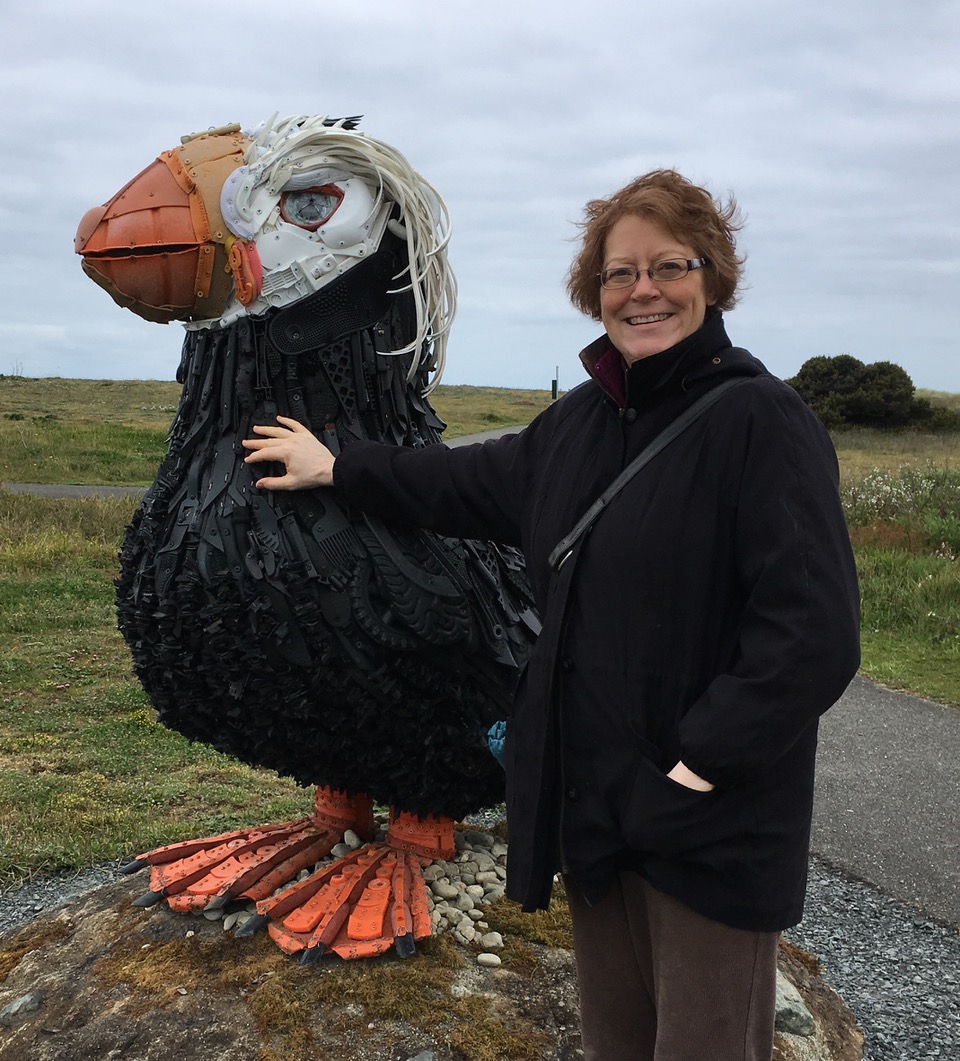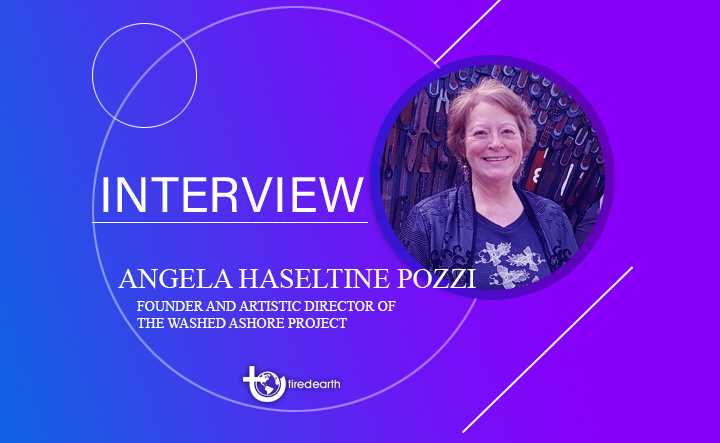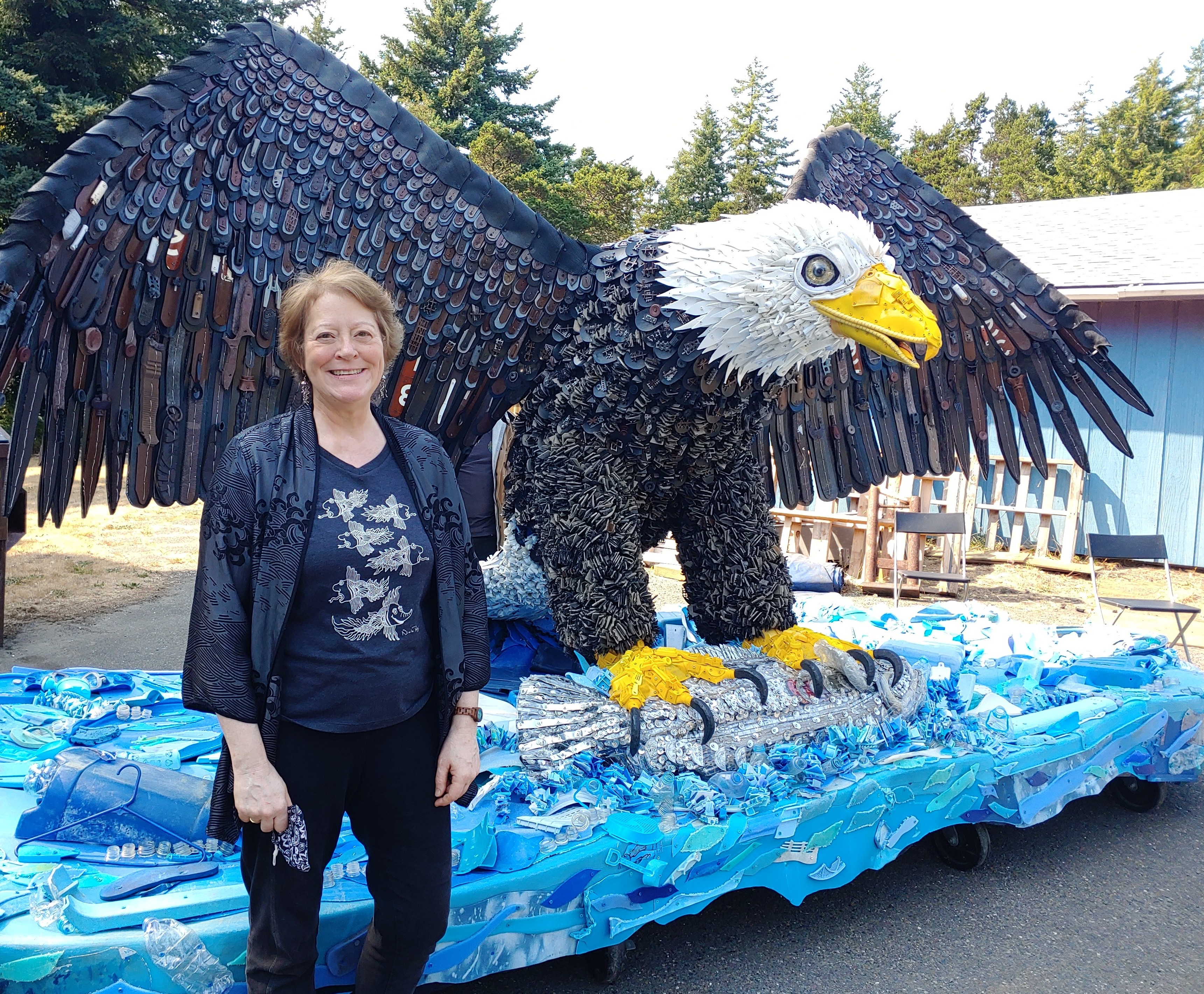03 Dec 2024

Angela Haseltine Pozzi
US
Angela’s work as an artist and educator gained new focus in 2010 when she founded the non-profit Washed Ashore: Art to Save the Sea.

This interview was conducted by Selva Ozelli
What was the idea/inspiration behind creating Washed Ashore?
Our founder, educator and artist, Angela Haseltine Pozzi was the child of two professional artists who were avid naturalists. Angela was an art teacher for 30 years in public schools and museums.
In Angela’s words…..“In 2010 I founded the educational non-profit Washed Ashore because I was shocked and heartsick at the amount of plastic. I found on the Pacific beaches in Oregon. I had known since childhood. I had recently lost my husband of 25 years to brain cancer and moved to the ocean to heal. Instead, I found an ocean that needed healing.
In my daily beach walks searching for a new meaning in life I kept seeing more and more plastic until one day I saw a mosaic of tiny plastic pieces that reached as far as my eye could see. I was sick to my stomach. I realized that plastic had been chewed up by the ocean and spit out into the size of sand. After doing research on the internet, I realized that animals were ingesting it, and our ecosystems were in danger. I vowed to save the ocean and use my skills as an artist and educator to carry the message to the public. I found my new purpose in life.”
Tell us about your Organization’s https://washedashore.org/exhibit-locations/ initiatives and art exhibits to educate a global audience about plastic pollution in the ocean and waterways and spark positive changes in consumer habits.
We live and breathe our mission: To build and exhibit aesthetically powerful art to educate a global audience about plastic pollution in the ocean and waterways and to spark positive changes in consumer habits.
We are strict about our craftsmanship and design and employ experienced artists, and involve thousands of people into our process of creating sculptures. We teach others to respect art as a language that can change hearts and minds. Education is at the core of all our work. The final sculptures must speak to the plastic pollution issue and be beautiful, but also horrifying. Each piece needs to awaken the senses and make the general public ask questions. It has always been our goal to reach the broadest range of people of all ages, abilities, interests and social economic status with our message. We seek to be extremely accessible with our work and allow touching and interacting with the work, which often makes it unforgettable.
Does your organization collaborate with Museums, Zoo’s Botanical Gardens, Universities?
Yes, collaboration is essential to our work. We lease our four traveling exhibits to various venues for periods of 6, 8 or 12 months to optimize our educational impact. When we exhibit at a venue we consider it a partnership. Our staff works with venue staff and volunteers by doing on-site trainings, walking tours, media interviews and educational presentations to community members and patrons. We often design an exhibit to fit their space. We also partner with the scientific community to extend their educational initiatives as well how to use our free curriculum.
We learn about each venues conservation and sustainability initiatives and encourage them to expand their commitments, such as offering more sustainable options in their cafes and gift shops. In 2014, we began our partnership with the U.S, National Oceanic and Atmospheric Administration (NOAA) to create a 12 unit Integrated Arts Marine Debris Curriculum. It can be found on our website and is offered to each venue at no cost. We have created an educational art cart exhibit for the Smithsonian National Museum of Natural History in Washington, D.C. and then created a commissioned 12 ft. vitrine sculpture for their Sant Ocean Hall. It has been on display since 2016. We often do commissioned work for a variety of venues.
This year The International Committee for Museums and Collections of Science and Technology (CIMUSET) which is a scientific committee of the International Council of Museums (ICOM) during its 48th #CIMUSET Annual Conference: “Museums & Environmental Concerns, New Insights” -7-11 November 2021, will address our planet's environmental concerns and how Science and Technology museums can approach and present this important issue via education and exhibitions. When did your organization get involved in climate change and plastic pollution related issues and what programs has it instituted in collaboration with Museums?
Washed Ashore began exhibiting it’s “Art to Save the Sea” in 2010 and has exhibited in over 35 locations since, with an expanding inventory of sculptures. We now have over 85 works of art that combine into 3 to 4 exhibits that are designed to fit indoor or outdoor spaces. We are constantly exhibiting and avoid ever storing the artwork. We have partnered and exhibited in museums, science centers, botanical gardens, universities, zoos and aquariums and estimate that over 30 million people have seen our work in person.
We have had exhibits a wide variety of places such as: Shedd Aquarium in Chicago, IL, Newport Oregon Visual Arts Center, U. S. State Department, Sea World Parks in Florida, Texas & California, Walt Disney World in Florida, United Nations Plaza, Denver, Colorado Zoo, Portland Oregon Community College, The Clinton Presidential Center in Arkansas and many more. Artwork is also encouraged to be photographed and shared on social media.
Our reach has been expanded through the internet to be truly global.
In the last few decades, the degradation of our environment with increased global warming, melting of the arctic, pollution, increased carbon footprint, ozone layer depletion, natural resource depletion, loss of endangered species, urban sprawl has gone up at an alarming rate. The worldwide covid-19 pandemic has also added to plastic pollution stemming from single use plastic equipment that are dumped into our world's wetlands, oceans and landfills. Tell us more about your organizations plastic pollution related initiatives, programs?
In our work we highlight threatened environments and animals, including climate change, pollution and degradation.
We understand that many environmental challenges are often easy to ignore or too great to want to spend time on. To avoid being overwhelmed with apathy or depression, our sculptures lure the general public with the colorful beauty of oversized animals. Everyone wants to go see a giant Penguin, Octopus or Parrotfish! Then they get up close and they start to see that it is all made of garbage. Then they read the sign and find out it is all plastic garbage from the beach. They start looking closely to easy identify common everyday plastic items they use in their own lives; lighters, flip flops, toothbrushes, bottle caps, beer cans. They suddenly realize they are part of the problem and part of the solution. This is our most powerful educational tool, the art itself. The next thing they realize is that the animal they are admiring is endangered by the very pollution it is made from. The setting of the animal, such as Daisy the Polar Bear, on her melting iceberg or Giacometti the River Otter next to a plastic river may also deliver a message. This multi-level multi-sensory experience is the power of Washed Ashore.

Another of Washed Ashore’s educational initiatives is the involvement of the general public in the making of the sculptures. Washed Ashore encourages beach clean-ups and, through careful direction in the home-base of Bandon Oregon, we conduct ongoing workshops with all ages and abilities to make small parts the sculptures. Volunteers wire-stitch, thread and weave processed debris into panel and kabobs that the artists then use to build the sculptures.
Your organization has gracefully participated in Tiredearth.com's #MASKUARY CAMPAIGN. What is a Campaign like #MASKUARY’s role in increasing public awareness in dealing with plastic pollution caused by PPE?
We recognize that plastic PPE is increasing on ocean shores around the world. Our organization is challenged by this fact and is looking at ways to encourage reusable and highly effective cloth masks with washable filters. We have not yet taken on the challenge of using PPE that has washed upon our shores. Our group’s home base is in a remote rural area where we are not yet finding large amounts of PPE on the beaches. We are strict to only use debris from the beaches When or if this type of debris increases we will investigate how to incorporate this type of debris in our sculptures.
2021 has been declared the “International Year of Creative Economy for Sustainable Development” by the United Nations. What partnerships does your organization have with the United Nations, the Ministerial Conference to end marine litter and plastic pollution?
Washed Ashore has worked with UNEP to display 4 large sculptures at the United Nations Plaza in NYC in 2017 during the first UN Ocean Conference. We have continued to be in touch with UNEP about how to continue our relationship to educate the general public with art.
How can people reach your Organization’s art exhibitions?
We proudly exhibit in highly visible and accessible venues and have reached over 30 million people in person with our work in over 11 years.
Do you have digital reach?
We have a wide digital reach and have had our artwork published in international and multi-language blogs, magazines, text books, videos, films and websites.